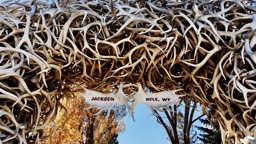I’ve always enjoyed the end of cottage season, that short interlude after the hustle and bustle of the summer has subsided and before the days grow cold. The constant hum of boats is replaced by the echoes of migrating birds, and the water becomes crystal clear, still retaining some of its warmth.
It was on one of these early fall days that I was standing up to my waist in the river, dreamily watching little perch dart in and out, nibbling at my toes. Suddenly, out of nowhere, a torpedo shot between my legs and was gone. It was quick, but not so quick that I didn’t catch a glimpse of its long, powerful tail working like a rotor rooter. I had just had a close encounter with a muskrat.
It was on one of these early fall days that I was standing up to my waist in the river, dreamily watching little perch dart in and out, nibbling at my toes. Suddenly, out of nowhere, a torpedo shot between my legs and was gone. It was quick, but not so quick that I didn’t catch a glimpse of its long, powerful tail working like a rotor rooter. I had just had a close encounter with a muskrat.
Muskrats have a PR problem, so much so that they are often referred to as “swamp bunnies.” Let me tell you, watching it motoring through the water, no one could have convinced me that it was any kind of bunny! It looked like a big, overgrown rat.
Muskrats get their name from the pair of scent glands located near the underside of their tail. They are not true rats, but are basically large field mice or hamsters that have adapted to living in and around the water. The most commonly distributed mammal in North America, muskrats also are the most valuable furbearers in the United States. At one time, they were also an important source of food (marketed as “hare” and “terrapin,” rather than “rat”) as well as a natural source of musky aroma used as a fixative in perfume. Who would have thought?
Much of the physiology and unique adaptations of this 2- to 4-pound, foot-long critter reflect the fact that it lives a semi-aquatic life. Muskrats are able to remain submerged for up to 15 minutes by reducing their heart rate, relaxing their muscles and storing an internal supply of oxygen. Their nostrils are shaped to allow them to recycle oxygen from recently exhaled breath. Their lips act like valves that close behind their front teeth, allowing them to gnaw underwater – just like beavers.
Muskrats get their name from the pair of scent glands located near the underside of their tail. They are not true rats, but are basically large field mice or hamsters that have adapted to living in and around the water. The most commonly distributed mammal in North America, muskrats also are the most valuable furbearers in the United States. At one time, they were also an important source of food (marketed as “hare” and “terrapin,” rather than “rat”) as well as a natural source of musky aroma used as a fixative in perfume. Who would have thought?
Much of the physiology and unique adaptations of this 2- to 4-pound, foot-long critter reflect the fact that it lives a semi-aquatic life. Muskrats are able to remain submerged for up to 15 minutes by reducing their heart rate, relaxing their muscles and storing an internal supply of oxygen. Their nostrils are shaped to allow them to recycle oxygen from recently exhaled breath. Their lips act like valves that close behind their front teeth, allowing them to gnaw underwater – just like beavers.
Champion swimmers. As I discovered, swimming is what muskrats do best. They can swim at speeds up to 3 mph. By way of comparison, human Olympic swimmers have been clocked at just over 4 mph. Muskrats can even swim backward (as in back-peddling while on their stomachs, not doing the backstroke!). You won’t see that in the Olympics!
Unlike beavers and otters, muskrats do not have webbed feet. Instead, they have four long toes on each foot with a fringe of specialized hairs. When swimming with alternate strokes of their hind feet, these hairs give them a kayak paddle-like effect. Although muskrats use their hind feet in swimming, the sculling action of their nearly hairless tails is thought to provide as much propulsion as the hind feet. When swimming on the surface, however, the tail seems to serve at most as a rudder.
Adding to their swimming prowess is the fact muskrats have built-in life preservers (and stylish ones at that!). The muskrat’s coat is a soft, dense, waterproof layer of fur, covered by long, brown, glossy guard hairs that protect the soft underhair from wear. The durability and silkiness of its chestnut to dark-brown fur has historically made the muskrat the mainstay of many North American fur trappers.
Muskrats are typically found in wet environments, including ponds, lakes, swamps and marshes. They make their homes in bank dens or lodges similar to those of the beaver, but constructed mostly of bulrushes, weeds, brush and mud. Often, their lodges are built up from the bottom of the wetland, or they anchor their lodges on submerged stumps in 15 to 40 inches of water.
Unlike beavers and otters, muskrats do not have webbed feet. Instead, they have four long toes on each foot with a fringe of specialized hairs. When swimming with alternate strokes of their hind feet, these hairs give them a kayak paddle-like effect. Although muskrats use their hind feet in swimming, the sculling action of their nearly hairless tails is thought to provide as much propulsion as the hind feet. When swimming on the surface, however, the tail seems to serve at most as a rudder.
Adding to their swimming prowess is the fact muskrats have built-in life preservers (and stylish ones at that!). The muskrat’s coat is a soft, dense, waterproof layer of fur, covered by long, brown, glossy guard hairs that protect the soft underhair from wear. The durability and silkiness of its chestnut to dark-brown fur has historically made the muskrat the mainstay of many North American fur trappers.
Muskrats are typically found in wet environments, including ponds, lakes, swamps and marshes. They make their homes in bank dens or lodges similar to those of the beaver, but constructed mostly of bulrushes, weeds, brush and mud. Often, their lodges are built up from the bottom of the wetland, or they anchor their lodges on submerged stumps in 15 to 40 inches of water.
Muskrat love – Not! Although they live in close proximity, they tend to be quarrelsome among themselves and can be tough fighters. Their chief predator is the mink, which uses their same burrow systems, digs into muskrat lodges, and may enter lodges through ventilation holes. Although muskrats are primarily vegetarians, they may also feed on crayfish, snails, frogs, slow-moving fish and small turtles. For a small animal, they are big eaters and consume about one-third of their weight every day.
Native to North America, the muskrat can be found in natural waterways and wetlands across the continent, as far north as the Arctic Ocean and south to the Gulf of Mexico. The species was introduced to Europe in 1905 and has now spread across much of Europe and into northern Asia. Many Native American stories celebrate its superior swimming abilities, and it has been an important source of commerce for centuries.
I’m embarrassed to say that my first reaction to its presence was not to marvel at its amazing aquatic adaptations, but to shriek, “Eek, a rat!”
Long-time contributor Nancy Cain, who holds a doctorate in animal behavior, has been working this summer on swimming in reverse.
Native to North America, the muskrat can be found in natural waterways and wetlands across the continent, as far north as the Arctic Ocean and south to the Gulf of Mexico. The species was introduced to Europe in 1905 and has now spread across much of Europe and into northern Asia. Many Native American stories celebrate its superior swimming abilities, and it has been an important source of commerce for centuries.
I’m embarrassed to say that my first reaction to its presence was not to marvel at its amazing aquatic adaptations, but to shriek, “Eek, a rat!”
Long-time contributor Nancy Cain, who holds a doctorate in animal behavior, has been working this summer on swimming in reverse.
 © Sven Weber - Fotolia
© Sven Weber - Fotolia 










